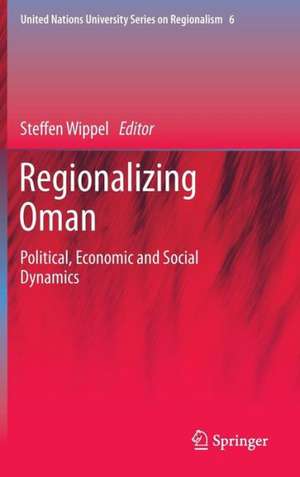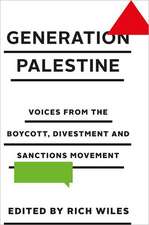Regionalizing Oman: Political, Economic and Social Dynamics: United Nations University Series on Regionalism, cartea 6
Editat de Steffen Wippelen Limba Engleză Hardback – 27 aug 2013
- Oman’s integration into global and regional flows of goods, capital, people and ideas;
- The multi-scaled political negotiation of such integration (or disintegration) processes;
- Consequences of suchlike processes and forms of regionalization for (translocal) actors;
- Ideas and strategic communication of regional belonging and the constitution of regions.
Each chapter deals with one or more of these issues. Part I deals with concepts of regionalisation and region-building and presents different approaches that accentuate certain dimensions of these processes and come from different disciplinary backgrounds. Part II focuses on the translocal, transnational and (trans)regional movement of people, their practices and imaginations, be they contemporary labour in- and out-migrants, returnees from Eastern Africa or nomadic tribal members. Part III takes a closer look particularly at economic issues and regionalisation processes that are mainly based on multiple trade links, regional development policies or politics of regionalism. Part IV analyses political and socio-cultural issues in regional and global perspectives.
| Toate formatele și edițiile | Preț | Express |
|---|---|---|
| Paperback (1) | 566.19 lei 38-45 zile | |
| SPRINGER NETHERLANDS – 25 aug 2015 | 566.19 lei 38-45 zile | |
| Hardback (1) | 577.17 lei 38-45 zile | |
| SPRINGER NETHERLANDS – 27 aug 2013 | 577.17 lei 38-45 zile |
Din seria United Nations University Series on Regionalism
- 15%
 Preț: 647.27 lei
Preț: 647.27 lei - 24%
 Preț: 790.70 lei
Preț: 790.70 lei - 18%
 Preț: 738.20 lei
Preț: 738.20 lei - 15%
 Preț: 645.47 lei
Preț: 645.47 lei -
 Preț: 393.35 lei
Preț: 393.35 lei -
 Preț: 395.09 lei
Preț: 395.09 lei - 15%
 Preț: 647.08 lei
Preț: 647.08 lei - 15%
 Preț: 651.67 lei
Preț: 651.67 lei - 18%
 Preț: 893.05 lei
Preț: 893.05 lei - 15%
 Preț: 641.20 lei
Preț: 641.20 lei -
 Preț: 442.46 lei
Preț: 442.46 lei - 18%
 Preț: 721.81 lei
Preț: 721.81 lei -
 Preț: 425.42 lei
Preț: 425.42 lei - 15%
 Preț: 646.11 lei
Preț: 646.11 lei - 18%
 Preț: 783.68 lei
Preț: 783.68 lei - 15%
 Preț: 690.94 lei
Preț: 690.94 lei - 15%
 Preț: 691.91 lei
Preț: 691.91 lei - 18%
 Preț: 727.80 lei
Preț: 727.80 lei - 18%
 Preț: 797.24 lei
Preț: 797.24 lei - 20%
 Preț: 560.30 lei
Preț: 560.30 lei -
 Preț: 433.68 lei
Preț: 433.68 lei - 15%
 Preț: 636.12 lei
Preț: 636.12 lei - 18%
 Preț: 940.09 lei
Preț: 940.09 lei - 15%
 Preț: 642.51 lei
Preț: 642.51 lei -
 Preț: 394.12 lei
Preț: 394.12 lei -
 Preț: 391.61 lei
Preț: 391.61 lei
Preț: 577.17 lei
Preț vechi: 721.47 lei
-20% Nou
Puncte Express: 866
Preț estimativ în valută:
110.44€ • 115.31$ • 91.40£
110.44€ • 115.31$ • 91.40£
Carte tipărită la comandă
Livrare economică 31 martie-07 aprilie
Preluare comenzi: 021 569.72.76
Specificații
ISBN-13: 9789400768208
ISBN-10: 9400768206
Pagini: 364
Ilustrații: XI, 351 p.
Dimensiuni: 155 x 235 x 25 mm
Greutate: 0.69 kg
Ediția:2013
Editura: SPRINGER NETHERLANDS
Colecția Springer
Seria United Nations University Series on Regionalism
Locul publicării:Dordrecht, Netherlands
ISBN-10: 9400768206
Pagini: 364
Ilustrații: XI, 351 p.
Dimensiuni: 155 x 235 x 25 mm
Greutate: 0.69 kg
Ediția:2013
Editura: SPRINGER NETHERLANDS
Colecția Springer
Seria United Nations University Series on Regionalism
Locul publicării:Dordrecht, Netherlands
Public țintă
ResearchCuprins
Preface; Fred Scholz.- Chapter 1. ''Regionalizing Oman'': A New Interest of Research on Oman and its Spatial Dimensions; Steffen Wippel.- Part I: Concepts of Regionalisation and Region-Building.- Chapter 2. Conceptual Considerations of “Space” and “Region”: Political, Economic and Social Dynamics of Region-Building.- Steffen Wippel.- Chapter 3. Theorizing Regionalism(s): When “Regions” Emerge and Interact; Ulrike Lorenz and Frank Mattheis.- Chapter 4. Working with “Translocality”: Conceptual Implications and Analytical Consequences; Katrin Bromber.- Part II. The Translocal, Transnational and Transregional Movement of People.- Chapter 5. “We are part of Zanzibar” – Translocal Practices and Imaginative Geographies in Contemporary Oman-Zanzibar Relations; Julia Verne and Detlef Müller-Mahn.- Chapter 6. Of Red Cells, Translocality and Origins: Inherited Blood Disorders in Oman; Claire Beaudevin.- Chapter 7. Oman-India Relations: Exploring the Long-Term Migration Dynamics; Samir Pradhan.- Chapter 8. Negotiating Authenticity and Translocality in Oman: the “Desertscapes” of the Harasiis Tribe; Dawn Chatty.- Part III. Micro and Macro Regionalisation through Economic Practices;.- Chapter 9. Re-reading the Role of Oman within its International Trade Relations. From 16th through to the 19th Centuries; Beatrice Nicolini.- Chapter 10. Oman and the Indian Ocean Rim – Economic Integration Across Conventional Meta-Regions; Steffen Wippel.- Chapter 11. Oman Caught Between the GCC Common Market and Bilateral Free Trade with the US: Is It Worth Breaking the Rules?; Anja Zorob.- Chapter 12. Musandam and its Trade with Iran. Regional Linkages across the Strait of Hormuz; Michael Benz.- Chapter 13. Is Littoralization Reconfiguring the Omani Territory?; Belgacem Mokhtar.- Chapter 14. The Impact of Shopping Malls on Traditional Retail Stores in Muscat. Case study of al-Seeb Wilayat; Montasser I. M. Abdelghani. Part IV. State andSociety in Regional and Global Perspectives.- Chapter 15. Private Documents as a Source for Regional History: The Archive of the ÝAbrÐyÐn of al-ÍamrÁÞ; Michaela Hoffmann-Ruf.- Chapter 16. Domesticating Local Elites. Sheikhs, Walis and State-Building under Sultan Qaboos; Marc Valeri.- Chapter 17. Musandam: Creating a New Region Across the Water; Gulshan Dietl.- Chapter 18. The Political Economy of Internationalization and Privatization of Higher Education in the Sultanate of Oman; Torsten Brandenburg.- Chapter 19. Bringing the Global and the Local Together through English in Oman; Rahma Al-Mahrooqi and Victoria Tuzlukova.- Concluding Remarks: Regionalizing Oman beyond Conventional Metageographies; Steffen Wippel.
Notă biografică
Very often economists and politicians tend to analyse past trends and future opportunities of regional economic integration in terms of pre-defined regional entities. More recent concepts across the disciplines emphasise a more open approach to regionalisation processes, focusing on region-building and on a more open definition of regions. Whereas Oman is regularly considered to be situated in MENA/ the Arab world, the paper takes a different perspective and sees it as part of the Indian Ocean world. It focuses on three dimensions of this integration process: on the institutional side – such as organisational membership or regional and bilateral economic agreements; on the development of material economic links, mainly trade; as well as on debates inside Oman about its regional orientation and belonging. The author shows that Oman has and is developing strong economic links with Indian Ocean rim countries and actively places itself in the area. The main motives behind that are to be found in endeavours to prepare the national economy for the post-oil era. Attempts to position Oman as a production place, a trade hub and a tourist destination have been strengthened. All this means that Oman is trying to produce and communicate a favourable geo-economic position. Finally, the presentation shows that the Indian Ocean is not a homogenous entity, but is divided into several sub-regions and has differing shapes, according to different temporal, institutional, material or discursive perspectives.
Textul de pe ultima copertă
This volume addresses the historical structures and current dynamics of Oman’s regionalization processes and their political, economic and social dimensions. It is based on an interdisciplinary and trans-regional dialogue between scholars from different social sciences and area studies such as political science, economics, management, economic and social geography, history, social anthropology and linguistics as well as Middle East/West Asian, gulf and African studies, and develops four major axes of research:
- Oman’s integration into global and regional flows of goods, capital, people and ideas;
- The multi-scaled political negotiation of such integration (or disintegration) processes;
- Consequences of suchlike processes and forms of regionalization for (translocal) actors;
- Ideas and strategic communication of regional belonging and the constitution of regions.
Each chapter deals with one or more of these issues. Part I deals with concepts of regionalisation and region-building and presents different approaches that accentuate certain dimensions of these processes and come from different disciplinary backgrounds. Part II focuses on the translocal, transnational and (trans)regional movement of people, their practices and imaginations, be they contemporary labour in- and out-migrants, returnees from Eastern Africa or nomadic tribal members. Part III takes a closer look particularly at economic issues and regionalisation processes that are mainly based on multiple trade links, regional development policies or politics of regionalism. Part IV analyses political and socio-cultural issues in regional and global perspectives.
- Oman’s integration into global and regional flows of goods, capital, people and ideas;
- The multi-scaled political negotiation of such integration (or disintegration) processes;
- Consequences of suchlike processes and forms of regionalization for (translocal) actors;
- Ideas and strategic communication of regional belonging and the constitution of regions.
Each chapter deals with one or more of these issues. Part I deals with concepts of regionalisation and region-building and presents different approaches that accentuate certain dimensions of these processes and come from different disciplinary backgrounds. Part II focuses on the translocal, transnational and (trans)regional movement of people, their practices and imaginations, be they contemporary labour in- and out-migrants, returnees from Eastern Africa or nomadic tribal members. Part III takes a closer look particularly at economic issues and regionalisation processes that are mainly based on multiple trade links, regional development policies or politics of regionalism. Part IV analyses political and socio-cultural issues in regional and global perspectives.
Caracteristici
Addresses the historical structures and current dynamics of Oman’s regionalization processes and their political, economic and social dimensions Presents and interdisciplinary and transregional dialogue between scholars from different social sciences and area studies Develops four major axes of research of Oman’s regionalization Includes supplementary material: sn.pub/extras























